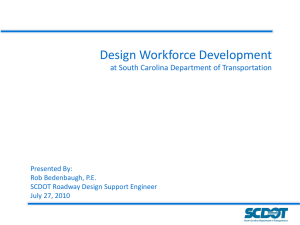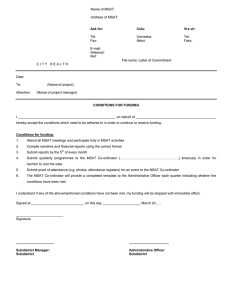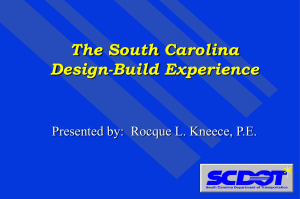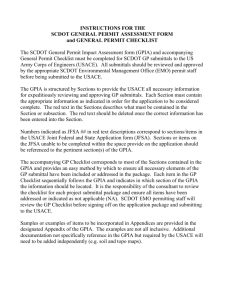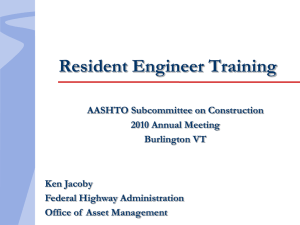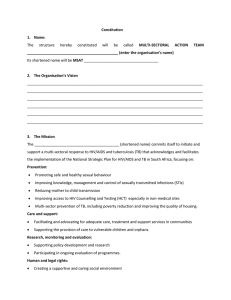Standard Language for CE Documents
advertisement
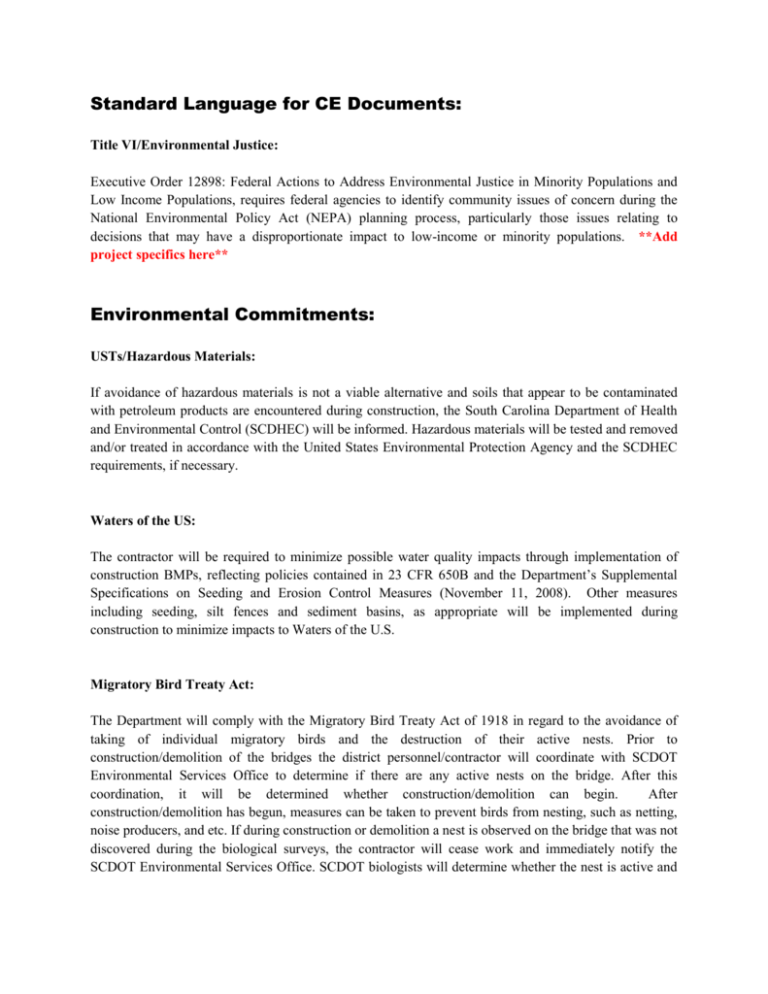
Standard Language for CE Documents: Title VI/Environmental Justice: Executive Order 12898: Federal Actions to Address Environmental Justice in Minority Populations and Low Income Populations, requires federal agencies to identify community issues of concern during the National Environmental Policy Act (NEPA) planning process, particularly those issues relating to decisions that may have a disproportionate impact to low-income or minority populations. **Add project specifics here** Environmental Commitments: USTs/Hazardous Materials: If avoidance of hazardous materials is not a viable alternative and soils that appear to be contaminated with petroleum products are encountered during construction, the South Carolina Department of Health and Environmental Control (SCDHEC) will be informed. Hazardous materials will be tested and removed and/or treated in accordance with the United States Environmental Protection Agency and the SCDHEC requirements, if necessary. Waters of the US: The contractor will be required to minimize possible water quality impacts through implementation of construction BMPs, reflecting policies contained in 23 CFR 650B and the Department’s Supplemental Specifications on Seeding and Erosion Control Measures (November 11, 2008). Other measures including seeding, silt fences and sediment basins, as appropriate will be implemented during construction to minimize impacts to Waters of the U.S. Migratory Bird Treaty Act: The Department will comply with the Migratory Bird Treaty Act of 1918 in regard to the avoidance of taking of individual migratory birds and the destruction of their active nests. Prior to construction/demolition of the bridges the district personnel/contractor will coordinate with SCDOT Environmental Services Office to determine if there are any active nests on the bridge. After this coordination, it will be determined whether construction/demolition can begin. After construction/demolition has begun, measures can be taken to prevent birds from nesting, such as netting, noise producers, and etc. If during construction or demolition a nest is observed on the bridge that was not discovered during the biological surveys, the contractor will cease work and immediately notify the SCDOT Environmental Services Office. SCDOT biologists will determine whether the nest is active and the species utilizing the nest. After this coordination, it will be determined construction/demolition can resume or whether a temporary moratorium will be put into effect. whether Stormwater: Stormwater control measures, both during construction and post-construction, are required for SCDOT projects constructed in the vicinity of 303(d), TMDL, ORW, tidal, and other sensitive waters in accordance with the SCDOT’s MS4 Permit. The selected contractor would be required to minimize potential stormwater impacts through implementation of construction best management practices, reflecting policies contained in 23 CFR 650 B and SCDOT’s Supplemental Specifications on Seed and Erosion Control Measures (November 11, 2008). Permitting: Impacts to jurisdictional waters will be permitted under a Department of the Army Section 404 permit from the U.S. Army Corps of Engineers. Based on preliminary design, it is anticipated that the proposed project would be permitted under SCDOT’s General Permit (GP). The required mitigation for this project will be determined through consultation with the USACE and other resource agencies. At this stage in project development, the Department plans to debit the Black River Mitigation Bank (or insert appropriate details here). Impacts to jurisdictional waters will be permitted under a Department of the Army Section 404 permit from the U.S. Army Corps of Engineers. Based on preliminary design, it is anticipated that the proposed project would be permitted under an Individual Army Corps of Engineers Permit (IP). SCDOT will provide the Army Corps with information regarding any proposed demolition activities during the Section 404 permitting process. Essential Fish Habitat: Avoidance and Minimization The selected contractor will be required to minimize impacts of siltation and erosion through implementation of Best Management Practices (BMPs). All in-water work will take place between November and March. Compensatory Mitigation The selected contractor will provide a compensatory mitigation plan to offset the permanent and temporary impacts to salt marsh and intertidal flats. The compensatory mitigation plan will include monitoring to verify that areas temporarily impacted by construction recover within two growing seasons; otherwise, additional compensatory mitigation may be required. Coordination The selected contractor will provide a detailed response to the National Marine Fisheries Service that includes a final calculation of direct and indirect impacts on essential fish habitat. Cultural Resources: If any cultural resources (artifacts/human remains) are encountered during the construction phase of the project, the South Carolina State Historic Preservation Office (SHPO) will be immediately notified and all work in the vicinity of the discovered materials and site work shall cease until SCDOT is otherwise directed. Mobile Source Air Toxics (MSATs): This project has been determined to generate minimal air quality impacts for CAAA criteria pollutants and has not been linked with any special MSAT concerns. As such, this project will not result in any meaningful changes in traffic volumes, vehicle mix, location of the existing facility, or any other factor that would cause an increase in MSAT impacts of the project from that of the no-build alternative. Moreover, EPA regulations for vehicle engines and fuels will cause overall MSAT emissions to decline significantly over the next several decades. Based on regulations now in effect, an analysis of national trends with EPA's MOVES model forecasts a combined reduction of over 80 percent in the total annual emission rate for the priority MSAT from 2010 to 2050 while vehicle-miles of travel are projected to increase by over 100 percent. This will both reduce the background level of MSAT as well as the possibility of even minor MSAT emissions from this project. Noise: SCDOT will inform local planning officials of future, generalized noise levels expected to occur in the project vicinity by the year 2035 after the FHWA has made a final decision on the EA. Noise Analysis: (if not needed): The proposed improvements do not represent a Substantial Horizontal Alteration. 23 CFR 772 states, “A substantial horizontal alteration would occur on a project that halves the distance between the traffic noise source and the closest receptor between the existing condition to the future build condition.” Also, this project does not include the addition of through traffic lanes, a significant change in vertical alignment or any other conditions that would qualify it as a Type I project. Therefore, the requirements for conducting noise studies under 23 CFR 772 do not apply. Displacements: The SCDOT will acquire all new right-of-way and process any relocations in compliance with the Uniform Relocation Assistance and Real Property Acquisition policies Ace of 1970, as amended (42 U.S. C. 4601 et seq.). The purpose of these regulations is to ensure that owners of real property to be acquired for Federal and federally-assisted projects are treated fairly and consistently, to encourage and expedite acquisition by agreements with such owner, to minimize litigation and relieve congestion in the courts, and to promote public confidence in Federal and federally-assisted land acquisition programs.
